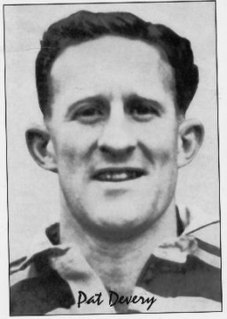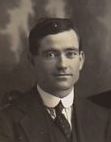Related Research Articles

Frank Dyson, also known by the nickname of "Spanky", was an English professional rugby league footballer who played in the 1950s and 1960s, and coached in the 1960s. He played at representative level for Great Britain and Yorkshire, and at club level for Huddersfield and Oldham, as a prolific left-footed goal-kicking fullback, i.e. number 1, and he coached at club level for Oldham.

The Huddersfield Giants are an English professional rugby league club from Huddersfield, West Yorkshire, the birthplace of rugby league, who play in the Super League competition. They play their home games at the John Smiths Stadium which is shared with Huddersfield Town F.C. Huddersfield is also one of the original twenty-two rugby clubs that formed the Northern Rugby Football Union in 1895, making them one of the world's first rugby league teams. The club itself was founded in 1864, making it the oldest rugby league club in the world.

The Fartown Ground or just simply Fartown is a sports ground located in the Huddersfield suburb of Fartown in West Yorkshire, England and is predominantly famous for being the home ground of Huddersfield Rugby League Club from 1878 to 1992. The grounds consisted of a rugby ground, a cricket ground used by Yorkshire County Cricket Club, Bowling greens and a running track as well as a pavilion. It was the scene of many great games, including the Challenge Cup finals of 1908 and 1910, several Challenge Cup semi finals, John Player Cup finals and international matches.

Hull Football Club, commonly referred to as Hull or Hull F.C., is a professional rugby league football club established in 1865 and based in West Hull, East Riding of Yorkshire, England. The club plays in the Super League competition and were known as Hull Sharks from 1996–99.

Albert Aaron Rosenfeld, also known by the nickname of "Rozzy", was a pioneer Australian rugby league footballer, a national representative whose club career was played in Sydney and in England. He played for New South Wales in the very first rugby league match run by the newly created 'New South Wales Rugby Football League' which had just split away from the established New South Wales Rugby Football Union. During his 16-year English career he set a number of try-scoring records including the standing world first-grade record of 80 tries in a season in 1913–14.

Victor John Hey, also known by the nickname of "The Human Bullet", was an Australian rugby league national and state representative five-eighth and later a successful first-grade and national coach. His Australian club playing career commenced with the Western Suburbs Magpies, and concluded with the Parramatta Eels. In between he played for a number of clubs in the English first division. He is considered one of Australia's finest footballers of the 20th century

William Batten was an English professional rugby league footballer who played in the 1900s, 1910s and 1920s. He played at representative level for Great Britain, England and Yorkshire, and at club level for Hunslet, Hull F.C., Wakefield Trinity, and Castleford, as a fullback, wing, or centre, i.e. number 1, 2 or 5, or, 3 or 4. He is noted as one of the greatest of his era, one of the game's first superstars, Batten was a brilliant athlete and a huge crowd-puller – and also well aware of his own worth. In 1988 he became one of the inaugural inductees of the Rugby Football League Hall of Fame. Batten is also a member of the Hull FC, and Wakefield Trinity halls of fame.

Douglas "Duggy" Clark MM was an English rugby league footballer, wrestler and World War I veteran. A Rugby Football League Hall of Fame inductee, he played for Huddersfield, Cumberland, England and the Great Britain national side, as a forward, during the era of contested scrums. Clarke helped Huddersfield to three Challenge Cups and seven Yorkshire County Cups, and is in the club's Hall of Fame.

Patrick Charles Devery was an Australian professional rugby league footballer who played in the 1940s and 1950s, and coached in the 1950s. An Australian international representative half, he played in Australia for the Balmain club, winning the 1944, 1946 and 1947 grand finals with them. He was also the 1947 season's top point-scorer. Devery then had a successful career playing in England for the Huddersfield club before returning to Sydney where he coached the Manly-Warringah club.
William Ward was an English professional rugby league footballer who played in the 1900s, 1910s and 1920s. He played at representative level for Great Britain and England, and at club level for Whitehaven, Egremont and Leeds, as a forward, during the era of contested scrums.

Frederick "Fred" Webster was an English professional rugby league footballer who played in the 1900s and 1910s. He played at representative level for Great Britain, England and Yorkshire, and at club level for Brotherton ARLFC, and Leeds (captain), as a forward, during the era of contested scrums.

Frank 'Bucket' H. Young was a Welsh rugby union, and professional rugby league footballer who played in the 1900s and 1910s. He played representative level rugby union (RU) for Glamorgan, and at club level for Cardiff RFC, London Welsh RFC and Bristol Rugby, and representative level rugby league (RL) for Great Britain and Wales, and at club level for Leeds, as a fullback, i.e. number 1.
Samuel William Jarman was an English professional rugby league footballer who played in the 1900s and 1910s. He played at representative level for Great Britain, and at club level for Leeds, as a fullback, or forward, i.e. number 1, or, 8 to 13, during the era of contested scrums.

John Henry Rogers was a Welsh rugby union and professional rugby league footballer who played in the 1900s, 1910s and 1920s. He played club level rugby union (RU) for Bridgend RFC and Cardiff RFC, initially as a wing, i.e. number 11 or 14, and later as a scrum-half, i.e. number 9, and representative level rugby league (RL) for Great Britain, Wales and Other Nationalities, and at club level for Huddersfield and Wakefield Trinity, as a wing, stand-off, or scrum-half, i.e. number 2 or 5, 6, or 7.
Frederick "Fred" Harrison was an English professional rugby league footballer who played in the 1910s. He played at representative level for Great Britain and England, and at club level for Leeds, as a forward, during the era of contested scrums.
The 1909–10 Northern Rugby Football Union season was the 15th season of rugby league football.
Harold Francis Rowe was a New Zealand rugby footballer who was part of the professional 1907–08 New Zealand rugby tour of Australia and Great Britain.

James Devereux (1887–1934), also known by the nickname of "Muscles", was a pioneering Australian rugby league footballer who played in the 1900s, 1910s and 1920s. A New South Wales state and Australia national representative three-quarter back, he played in the New South Wales Rugby Football League premiership from its first season in 1908 for the North Sydney club, before playing several seasons in England will Hull FC. He later returned to Australia and coached North Sydney.
The 1909–10 Challenge Cup was the 14th staging of rugby league's oldest knockout competition, the Challenge Cup.
George Thomas Cottrell, also known by the nickname of "Rocky", was an English rugby union and professional rugby league footballer who played in the 1900s and 1910s. He played representative level rugby union (RU) for Gloucestershire and at club level for Cheltenham All Saints RFC and Cheltenham RFC, as a full-back, or centre, i.e. number 15, or 12 or 13, and club level rugby league (RL) for Halifax, Hull F.C. and Keighley, as a wing, or centre, i.e. number 2 or 5, or, 3 or 4.
References
- ↑ Rugby League Project
- ↑ Whiticker, Alan. "Andy Morton". rugbyleagueproject.org. Shawn Dollin, Andrew Ferguson and Bill Bates. Retrieved 21 July 2014.
- ↑ Haddan, Stephen (1991). History of the NSW Rugby League Finals. Australia: Powers Brewing. p. 11. ISBN 9780646050980 . Retrieved 21 July 2014.
- ↑ "Australian Kangaroos Player Register" (PDF). nrl.com. Australian Rugby League Commission. Archived from the original (PDF) on 3 December 2013. Retrieved 21 July 2014.
- ↑ "Hull's Australians". hullfc.com. Hull F.C. Archived from the original on 27 April 2014. Retrieved 21 July 2014.
- ↑ Alan Whiticker/Glen Hudson: The Encyclopedia of Rugby League Players. (1995 edition) ISBN 1875169571
- ↑ "Andy Morton". nrlstats.com. Sports Data. Archived from the original on 27 July 2014. Retrieved 21 July 2014.
- ↑ Sydney Morning Herald - Death/Funeral Notice - 19/10/1950